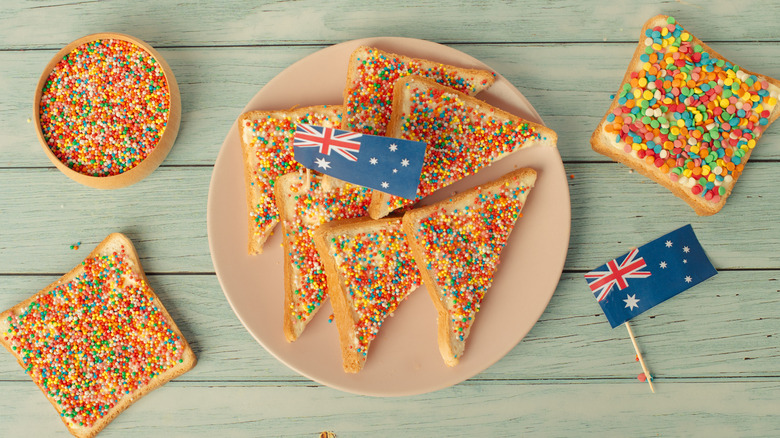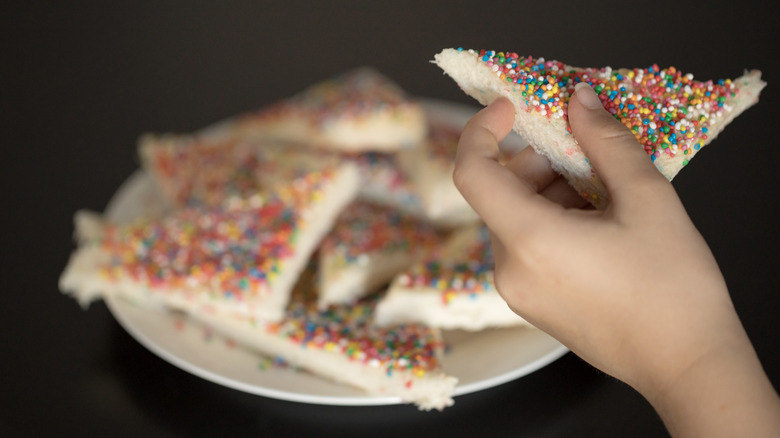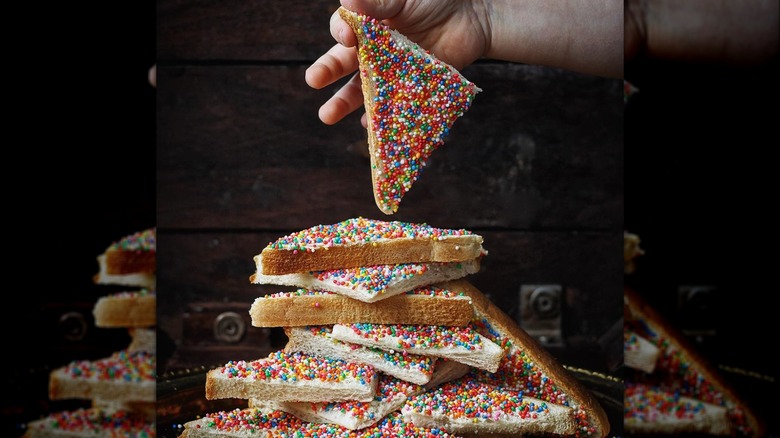Why Do We Put Sprinkles On Fairy Bread?
If you were to attend a children's birthday party in the U.S., you'd expect to see conical hats, balloons, and a bright, frosted birthday cake. Attend the same kind of celebration in Australia or New Zealand, and chances are good the birthday cake will be accompanied or even replaced by bread slices coated in butter and rainbow sprinkles.
This unique treat is known as fairy bread. Though the combination may seem peculiar to outsiders, the whimsically-named goodie is a regular treat in Australian and New Zealand festivities. Arguably, as with an ice cream sundae, the best part of fairy bread is the sprinkles, or "hundreds-and-thousands" as Aussies and Kiwis call them. Sprinkles are inexpensive, easily found at most grocery stores, and add crunchiness, sweetness, and colors, so it is no wonder they are the topper on such a popular, joy-inducing dish. The sprinkles make fairy bread the cross-section of maximal delight for minimal effort.
Hundreds and thousands of sparks of joy
While the cuisine in Australia largely emulates that of the U.K. and the U.S., the Oceanian country boasts some distinctive food staples, including vegemite, pavlova, flat whites, and, of course, fairy bread. The fairy bread construction process is delightfully simple: take a piece of white bread, spread a layer of butter on top, and then press the slice onto a flat surface full of sprinkles. The sprinkles are the star of the show — the butter is simply there to help the sweet bits stick to the bread and add a slight depth of flavor. This uncomplicated yet delicious treat has long enchanted partygoers down under. One Australian TikToker explains the appeal of fairy bread while demonstrating how to make it.
@daenskitchen Fairy bread #fairybread #australia #australiantiktok #australianfood
The poster affectionately describes the bread as "sweet, buttery, and crunchy." It is very much the sum of its parts in taste, but it is much more in terms of the feelings and memories it evokes — the Aussie declares them "extremely nostalgic."
The roots of fairy bread run deep
Fairy bread has offered a sweet and sentimental appeal in the region for more than a century. The dish can be traced back to the 1920s when it was mentioned in a local Australian newspaper, The Hobart Mercury. Many people believe the term comes from Robert Louis Stevenson's poem "Fairy Bread," which was published in 1885.
Though it has grown into a cultural phenomenon of its own, fairy bread is not the only dish of its kind. In the Netherlands and Belgium, folks frequently indulge in hagelslag — bread slices coated in butter and rich chocolate sprinkles. The Dutch treat is essentially the same as fairy bread, though is typically enjoyed as a meal — no special occasions required. And who knows, perhaps frequent hagelslag consumption is related to the Netherlands' consistent ranking as one of the happiest countries in the world.
Luckily, you need not travel to Oceania or Europe if you want to try fairy bread or hagelslag. Part of its beauty is how easily you can assemble it. With three basic ingredients and thirty seconds of your time, you too can feel the fantastical magic of fairy bread, particularly if you need a break from our equally nostalgic version of the treat, cinnamon sugar toast.


